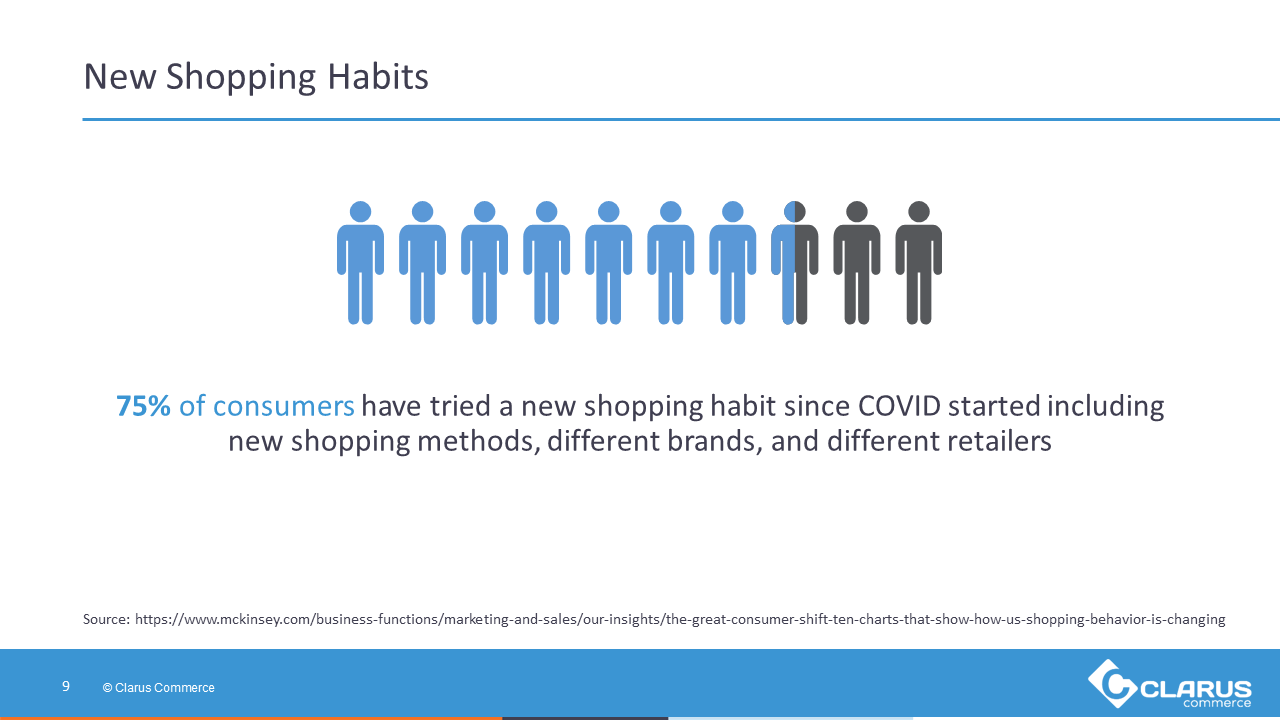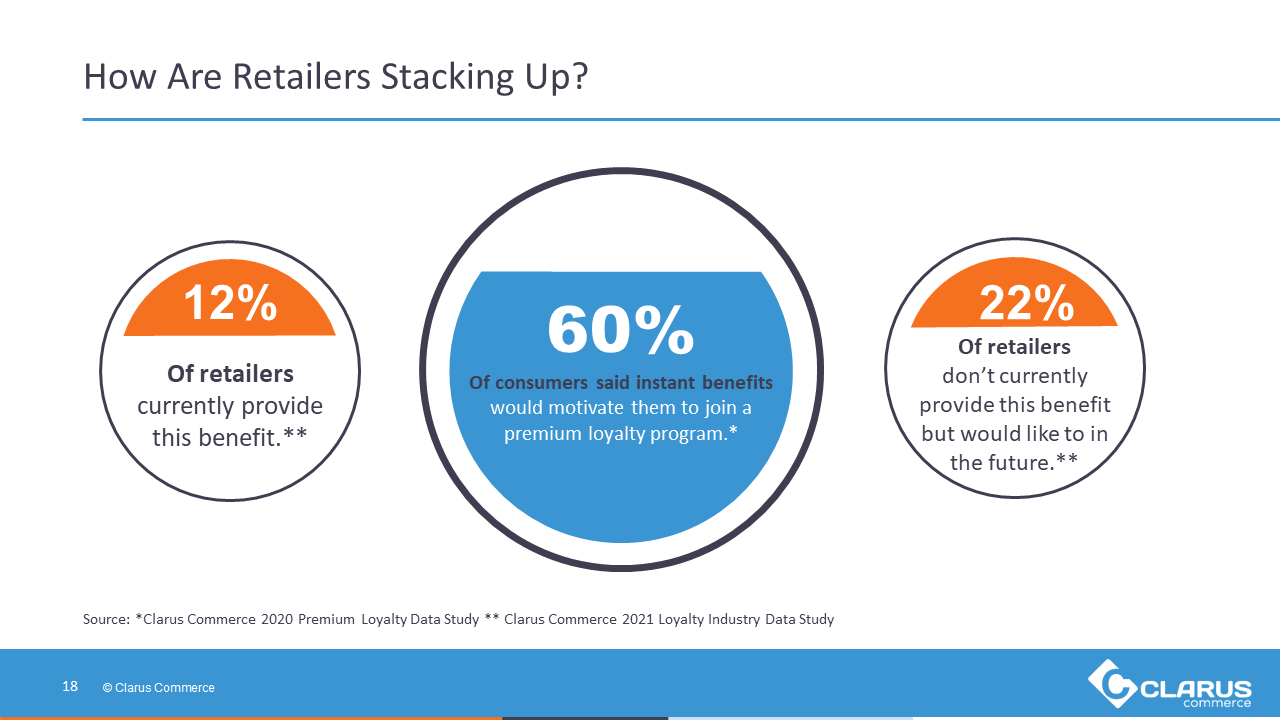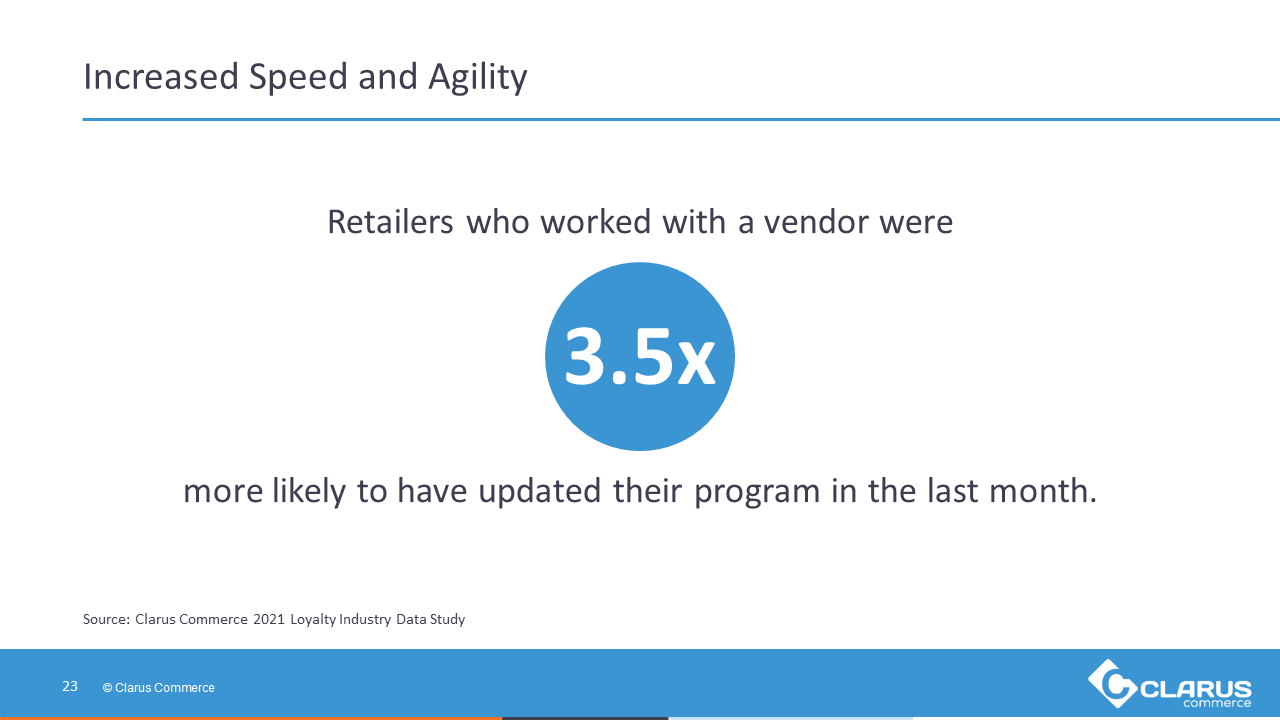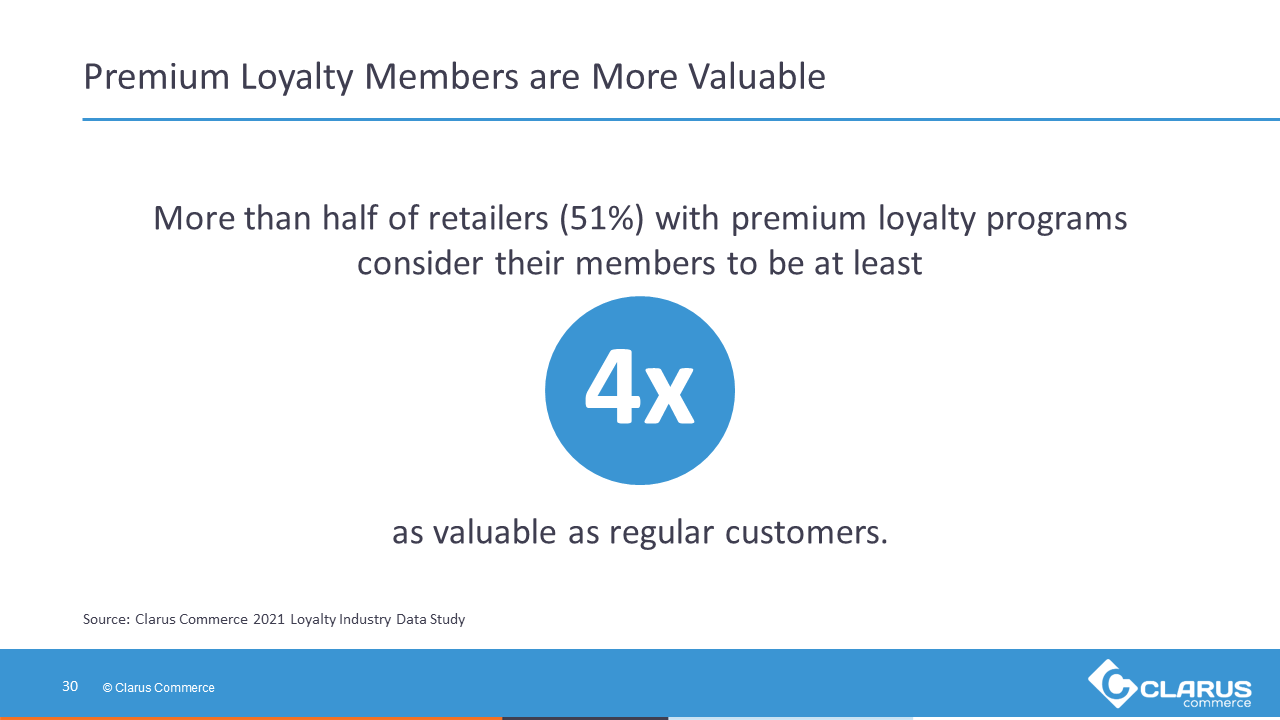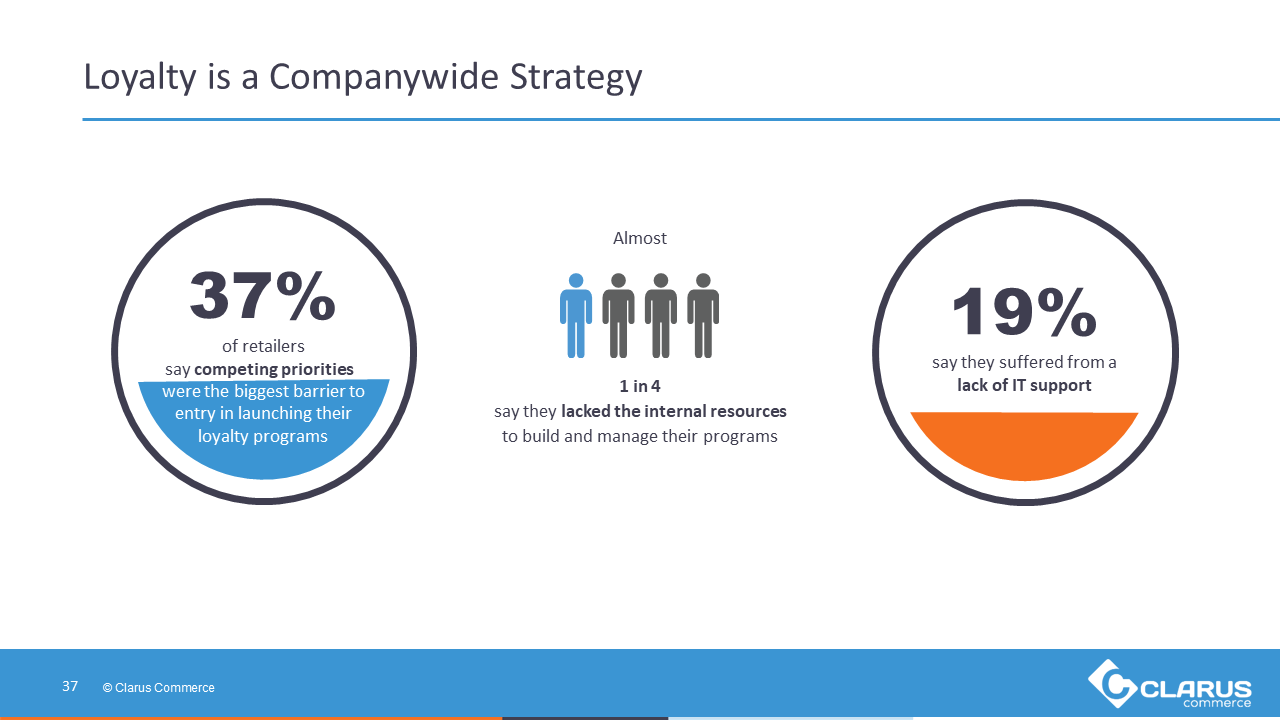Did you know that 90% of retailers say expanding their respective loyalty programs is a priority for 2021?
There has been plenty of change in the past year, thanks to COVID-19 and its massive impact on consumer behavior and retailers themselves.
Consider that nearly two-thirds of consumers say their loyalty is more difficult for retailers to maintain than ever before. And that was BEFORE the pandemic.
Due to COVID-19, the challenges for retailers are immense. Retaining customer loyalty is paramount.
We wanted to better understand retailers as they emerge from the pandemic from a loyalty perspective. We surveyed 300 loyalty marketers in the U.S. retail industry about current and future loyalty strategies, barriers to loyalty program innovation, and expectations moving forward.
As a result, we published our 2021 Loyalty Industry Data Study and discussed it during a webinar on March 23, 2021, titled, “New Data Reveals Loyalty Marketers’ 2021 Priorities.”
See the full webinar recording here.
Paul Wolfer, B2B Marketing Manager, Clarus Commerce; and Carlos Dunlap-Beard, VP of Loyalty Solutions at Clarus Commerce, served as co-hosts of the webinar.
Loyalty is harder than ever before, and COVID-19 elevated that to a new level.
How will retailers tackle these challenges in 2021?
Here are the most important takeaways from the webinar.
COVID-19’s Impact on Loyalty
“2020 changed us, how we live, how we connect, and how quickly we adapt to change,” Paul said during the webinar. “That’s true for people, as well as for businesses – especially retailers. Loyalty was hard enough pre-pandemic, but COVID-19 changed the game and pushed more people online than ever before.”
Carlos cited some eye-opening statistics related to COVID-19’s impact on consumer behavior.
Consider that 75% of consumers have tried a new shopping habit since COVID-19 started.
Last year an IBM report showed that COVID-19 accelerated the shift away from physical stores to digital shopping by roughly five years.
“We leapfrogged five years in less than one year,” Carlos said. “And those who already had a strong data and digital strategy evolved more efficiently and profitably than those who weren’t prepared.”
Also, Walmart’s e-commerce growth reached nearly 80% in the past year. And that growth includes categories like pet supplies, hobbies, and groceries.
That’s why retaining your loyal customers is more important now than ever.
Earning customer loyalty was challenging for retailers before the pandemic. Now, it’s become exponentially more difficult as consumers have seemingly infinite options.
Those retailers who adapted well since the pandemic started will be ahead of the game when it comes to earning loyalty.
“Customers are going to remember the brands that gave them value during the pandemic,” Paul said.
What Your Customers Want from a Loyalty Program
Loyalty program members want benefits, and they want them fast. Instantly, if possible.
According to the 2021 Loyalty Industry Data Study:
- 41% percent said their loyalty program members receive benefits within the first month.
- 42% percent said their members receive benefits within the first week.
Is faster better?
“Brands have real considerations to consider because rewards budgets aren’t limitless,” Carlos explained. “So, if you front-load benefits, you need to be certain there will be a significant payoff down the road.”
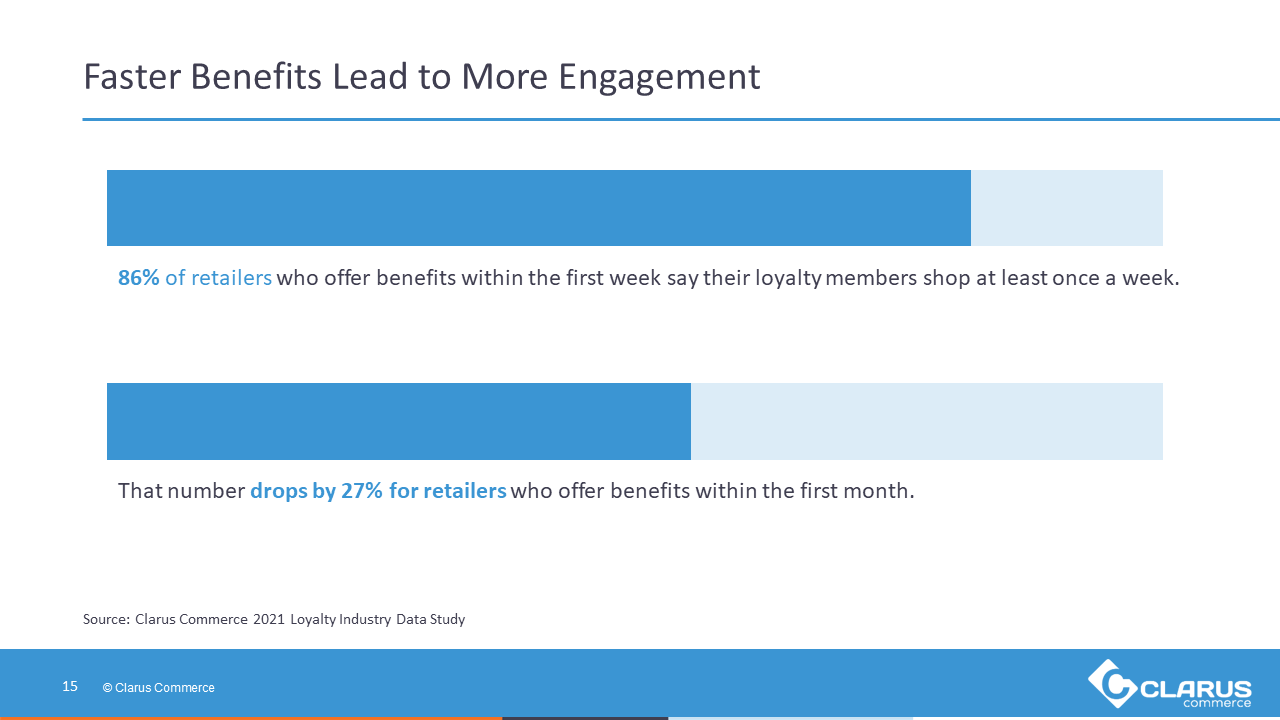
But consider this stat: 86% of retailers offering benefits in the first week say their customers shop at least once per week.
- Retailers that offer benefits sooner also experience faster ROI: Over half of respondents (62%) who offer benefits within the first week see ROI within the first six months.
- For those who offer benefits within the first month, only 21% see ROI within the first six months.
“That’s awesome because most traditional loyalty programs take between 1.5 to two years to break even from investments in technology implementation, plus ongoing platform, program management, and reward fees,” Carlos added.
How Other Retailers are Stacking Up
“We definitely live in a world of instant,” Paul said.
Paul outlined a disconnect between our 2020 Premium Loyalty Data Study and our 2021 Loyalty Industry Data Study around instant loyalty program benefits.
In last year’s Consumer Study 60% of respondents said instant benefits would motivate them to join a premium loyalty program.
Conversely, in this year’s B2B Data Study, 22% of retailers currently don’t provide this benefit but would like to in the future, and 12% currently provide this.
According to the Premium Loyalty Study, 66% of consumers said free shipping would motivate them to join premium loyalty programs; yet 13% of retailers don’t currently provide this benefit but would like to in the future.
“It seems like many retailers are not prioritizing some of the core benefits today’s consumers expect, especially around premium loyalty programs,” Paul said. “The biggest lesson with all of this, though, is that even the right benefits today might not be the ones members want in the future. Program testing and optimization over time are key.”
Working With Loyalty Partners
To outsource or not to outsource your loyalty program, that is the question
Our 2021 Loyalty Industry Data Study shows that 51% of retailers that work with a vendor see ROI within six months.
One way to ensure your program is being updated and evolved is by working with a loyalty vendor. The main benefits of using a loyalty partner are greater agility and success.
“Think about it,” Carlos explained. “Leaning on a partner is a lot different than leaning on internal shared services to get something done. Dealing with someone who specializes in a discipline means they’re usually up to date on their craft, follow best practices, and are developing toward the future.”
Working with a loyalty vendor is a good thing. Even if you only consult them periodically for strategy, vision, best practices, or marketplace scans.
Consider that retailers who work with an experienced partner/vendor proved to be 3.5x more likely to have updated their loyalty programs in the prior month.
“Updates are essential to ensuring programs stay relevant and valuable to members,” Carlos said. “Having nearly a 50% improvement in member frequency of purchase–compared to retailers who manage their program internally–can lead to significantly more revenue.”
The Rise of Premium Loyalty
Two statistics from our Loyalty Industry Data Study clearly indicate the attention premium loyalty is receiving now.
Ninety percent of retailers said the launch of Walmart+ last year influenced their decision to launch a premium loyalty program in 2021.
Also, 95% of retailers with only traditional loyalty programs have discussed launching a premium loyalty program in 2021.
These are staggering stats, to say the least.
“Premium Loyalty isn’t a new concept, but it is seeing a renaissance and serious uptick, with many other retailers getting on board,” Carlos explained. “The days of requiring customers to spend over $1,000 to be ‘loyal’ and get the best benefits down the road are quickly declining.”
That’s why many retailers across many categories are investing in premium loyalty programs, not just Amazon and Walmart.
“It’s a trend that is continuing to grow and take over the retail space,” Carlos added.
So, how valuable are premium loyalty members?
More than half of retailers (51%) with premium loyalty programs consider their members to be at least 4x more valuable than non-members.
That is quite impressive!
According to a 2020 McKinsey Study regarding the impact of paid loyalty programs:
- 43% of consumers are more likely to buy weekly since joining.
- 59% are more likely to choose the brand that offers the paid program over competitors.
- 62% are more likely to spend more with the brand than they did prior to joining the program.
According to our own 2020 premium data study that captured responses from 2,000 consumers:
- 70% of those not in a premium loyalty program would join one if their favorite retailer offered one.
- 74% of millennials plan to join additional premium loyalty programs.
Loyalty Challenges in 2021
For 37% of retailers, competing priorities were the biggest barrier to entry in launching their loyalty programs.
Almost one in four say they lacked the internal resources to build and manage their programs.
And nearly 20% said they suffered from a lack of IT support.
These points reinforce the premise that loyalty is something that needs to be a commitment from the top down.
“Loyalty is more than just a program,” Carlos said. “It’s a companywide effort. Those who have had success operating their program in-house had a champion in the C-Suite who made it a priority from the top down.”
Many brands struggle with the budget.
“It can be a big investment, but that’s how it should be looked at,” Carlos added. “An investment that needs to deliver a positive return – sooner rather than later.”
Paul added: “Every retail marketer we asked had some type of barrier to launching a loyalty program. While some retailers truly have the resources to manage it in-house, many others struggle to find them.”
These are some of the loyalty challenges for brands moving forward.
Moving Forward As You Prioritize Loyalty in 2021
“Consumers want better from their brands,” Carlos said. “What can we do that adds real value for our customers? Even if it’s something they didn’t ask for. It’s OK to be bold. This is the time to be bold if you’re a brand. It’s OK to come up with a new benefit for your customers. Put it out there and see if customers like it.”
While 2020 was largely a year of being reactive, 2021 is the year for retailers to be proactive with their customer loyalty efforts.
Combine a massive shift in consumer behavior and a major move toward online buying, the loyalty stakes are sky-high for retailers.
“Go above and beyond your competitors,” Carlos said. “It’s no longer enough just to have a loyalty program. That just won’t do. Spend some time making your customer loyalty and engagement strategy better. More appealing. More engaging. More rewarding. More meaningful and personalized to the individual.”
Build or revamp a loyalty program that focuses on:
- Instant benefits
- Convenience of shopping and engagement
- Virtual experiences
- Personalized offers
- Immediate value
- The option to join a premium tier
- Testing and updates over time
We all know that earning customer loyalty is more difficult than it used to be.
Make 2021 a year where your brand puts loyalty on the front burner and your customers’ needs first.
To listen to the webinar, please click here.
